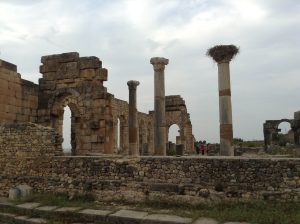The destroyed Roman city of Volubilis in Morocco, situated in the center of a lush plain, is Morocco’s best-preserved archaeological site. Its most impressive features are the many exquisite mosaics that have been kept in situ, and it was designated a Unesco World Heritage site in 1997. Volubilis is around 33 kilometers north of Meknes and can easily be paired with adjacent Moulay Idriss Zerhoun to make a superb day excursion from Meknes or Fez.
Only roughly half of the 40-hectare Volubilis in Morocco site has been excavated. The more well-known monuments are located in the northern half of the site, farthest from the entrance in the south.
The sun can be harsh on a hot day, so bring a hat and plenty of water. Spring is the finest season, when wildflowers bloom among the abandoned stones and the neighboring fields are at their greenest. Volubilis is most spectacular at sunset when the last rays of the sun illuminate the ancient columns.
Although several structures are cordoned off, you can roam the grounds at your leisure. Just beyond the entrance gate is a tiny on-site museum that showcases the ancient city’s most notable treasures and includes some of the coveted discoveries, including some beautiful bronzes, while many remain in Rabat’s Archaeology Museum.
Using a tour guide
The information boards have been greatly updated, and they now explain what you’re viewing in English, French, and Arabic. It’s well worth hiring a guide, especially if you’re short on time. Official guides are stationed at the site’s entrance and offer good one-hour tours for Dh250. The guides speak almost every language known to man. To get the most out of your tour, insist on one that speaks your language well.
Allow at least two hours if you like to explore on your own.
Volubilis in Morocco of antiquity
Although it is the least impressive portion of the site, the olive presses here. Like the abundant olive fields in the surrounding area, demonstrate the economic underpinning of ancient Volubilis – seek for the flat presses and stone storage vats sprinkled across the site. Private olive presses were available to wealthy houses.
Buildings
The remnants of Galen’s Thermal Baths can be found next to the House of Orpheus. Despite being mostly shattered, they demonstrate the well-developed underfloor heating in this Roman hammam (look for the low arches). The communal restrooms are located next to the steam room. Where citizens can do their business while still conversing.
The Capitol, Basilica, and 1300-square-metre Forum are often built on a high site. The Capitol, dedicated to the Triad of Jupiter, Juno, and Minerva, dates from AD 218; the Basilica and Forum are located directly to its north. If the birds are nesting at the time of your visit. The restored columns of the Basilica are frequently topped with storks’ nests – an iconic Volubilis image. Around the Forum are several plinths etched with Latin inscriptions that would have supported statues of the great and good. Keep a look out for the carved stone drain-hole cover, an inconspicuous example of Roman civil engineering.
The marble Triumphal Arch was built in 217 to honor Emperor Caracalla and his mother, Julia Domna. The arch, which was originally topped with a bronze chariot, was rebuilt in the 1930s, and the mistakes made then were corrected in the 1960s. The hill to the east offers a stunning perspective of the entire site.
Mosaic Houses
The House of Orpheus is the finest and largest home, with a mosaic showing Orpheus captivating animals while playing the lute and a dolphin mosaic in the dining room. The private hammam has a caldarium (hot room) with visible steam pipes, a tepidarium (warm room), a frigidarium (cold room), and a solarium.
A handful more roped-off mosaics can be found on the left, immediately before the triumphal arch. One, in the House of the Acrobat, represents an athlete receiving a prize for winning a desultory race, a competition in which the rider had to dismount and jump back on his horse as it raced along. To the west of here lies the House of the Dog, famous not for its mosaics but for a lonesome granite plinth with a large phallus carved into the top of it – this business was formerly a brothel for exhausted warriors who would stop off here after making it back to the triumphal arch after battle.
The ceremonial road, Decumanus Maximus, extends up the slope to the northeast from the arch. The houses on either side of it have the nicest mosaics on the site. The first, on the other side of the arch, is known as the House of the Ephebus and has a completed mosaic portraying Bacchus in a chariot driven by panthers.
The House of the Columns is named for the columns that are positioned in a circle around the interior court – take note of their many styles, which include spirals. Adjacent to this is the House of the Knight, also known as the House of the Cavalier/Rider, with its completed mosaic of Bacchus and Ariadne. The naked Ariadne has suffered from the attention of admirers.
The House of Hercules
The next four homes are called for their magnificent mosaics: the House of Hercules’ Labors, the House of Dionysus and the Four Seasons, the House of the Nymphs Bathing (albeit the nymph mosaics are seriously damaged), and the House of the Wild Beasts. The first is almost a circular comic strip that recounts the Twelve Labours. Several of Hercules’ heroic acts were said to have occurred in Morocco, making him a famous figure of the period.
Some of the best mosaics are kept for last. Cross the Decumanus Maximus and make your way to the House of Venus, King Juba II’s residence. There are two very good mosaics here, both with semi-romantic themes. The first is the Abduction of Hylas by the Nymphs, an erotic composition depicting Hercules’ lover Hylas being enticed away from his duty by two lovely nymphs. Diana Bathing is the subject of the second mosaic. The hunter Acteon caught sight of the virgin goddess in her bath and changed him into a stag as punishment. Acteon can be seen sprouting horns, about to be hunted and devoured by his band of hounds – the fate of fabled peeping toms worldwide.
Getting to Volubilis in Morocco
The simplest and quickest way to get to Volubilis is to rent a big cab for the return trip. A half-day trip from Meknes should cost Dh350, which includes a couple of hours at the site and a visit at Moulay Idriss Zerhoun (worth an overnight stay in itself). The identical trip from Fez (almost twice the distance) will cost around Dh1000.
A less expensive option is to take a shared grand cab from Meknes to Moulay Idriss Zerhoun (Dh10; ask for Zerhoun). and then book a grand taxi to Volubilis (Dh30 complete hire, one way). If the cab waits for you and takes you back to Meknes, the fare is Dh120. If you haven’t prearranged to be picked up. Simply ask the guardian at Volubilis parking park to find you a cab. It should be noted that shared grand taxis to Moulay Idriss only run from the Meknes Institut Français.
If the weather isn’t too hot, it’s a nice one-hour (one-way) stroll between Moulay Idriss Zerhoun and Volubilis in Morocco. Alternatively, schedule a donkey ride through Dar Zerhoune in Moulay Idriss Zerhoun (Dh150, one hour) and take a taxi back.



